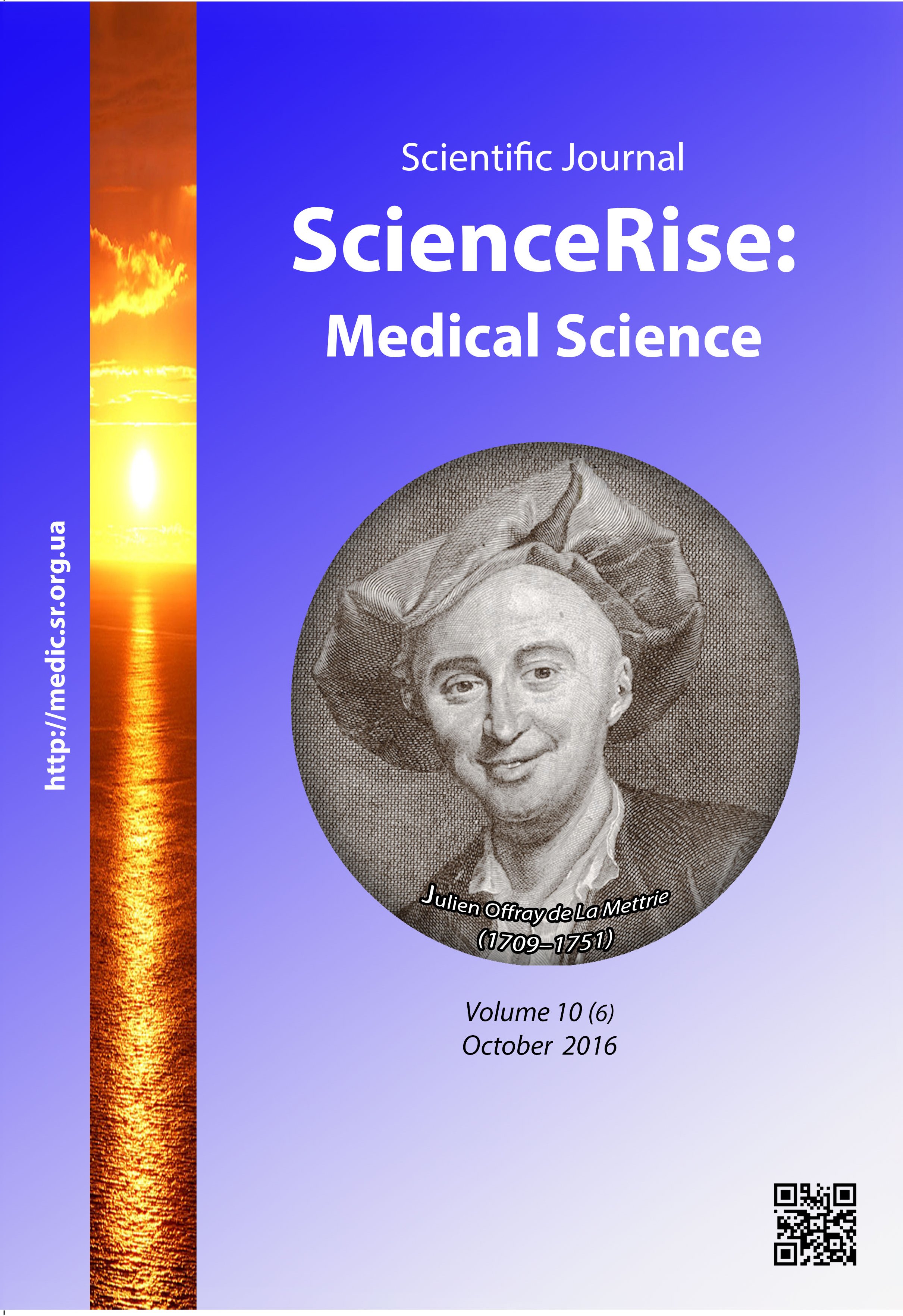The state of gastric mucosa in patients with chronic gastritis, associated with osteoarthritis under conditions of the therapy with non-steroid anti-inflammatory preparations
DOI:
https://doi.org/10.15587/2519-4798.2016.80649Keywords:
Chronic gastritis, osteoarthritis, NAP-therapy, gastric mucosa, histopathological changesAbstract
Aim of research. To detect the features of histopathological changes of gastric mucosa (GM) in patients with chronic gastritis (CG) associated with osteoarthritis (OA) under conditions of NAP-therapy.
Materials and methods of research. The complex examination was carried out in 507 patients, 40 - 65 (52,5±4,32) years old, including 310 women and 197 men. All patients were divided in 2 clinical groups: 1 group included 357 patients with OA, associated with CG, 2 group ‒ 150 patients with CG without joint pathology. Then the patients with CG of both groups were divided depending on the presence of atrophy and its stage: non-atrophic gastritis (NAG) took place in 117 and 51 patients from І and ІІ groups, respectively; initial atrophy (IA) that corresponds to the I and II stage of atrophy, according to OLGA system, was detected in 128 and 54 patients from І and ІІ groups, respectively; the heavy atrophy (HA) that corresponds to ІІІ and ІV stage of atrophy, according to OLGA system, was fixed in 112 and 45 patients from І and ІІ groups, respectively.
Нp-infection was detected using two methods: fast urease test and cystoscopy of smears of imprints, colored according to Romanovsky-Gimza. The half-quantity assessment of inflammatory infiltrate and of the stages of atrophic changes intensity was carried out in GM histological preparations, received from the antral part and gastric body, using visual-analogous scale.
Results of research. At the comparison of Нр- colonization frequency between groups it was established, that the number of Нр – positive patients with NAG among I group was 1,5 times less (c2=8,14, р=0,032), than in ІІ group. It was established, that in І group at both non-atrophic and atrophic gastritis Нр-infection did not influence the intensity of disease. But at CG without concomitant pathology the integral index of inflammation in Нр-positive persons was 1,8 times higher (р<0,05), than in Нр-negative ones. The decrease of GM parenchyma thickness was observed in patients of both groups at the atrophy progression: in I group with AG the GM thickness in gastric body was 1,5 less than at NAG (р<0,05), the increase of stroma part in 1,6 times (р<0,05) comparing with NAG was observed in II group at AG.
Conclusions. At NAG, associated with OA the number of Нр – positive patients was 1,5 times less (c2=8,14, р=0,032), than among patients with NAG without associated pathology. The intensity of inflammation in GM at CG in combination with OA in Нр-positive and Нр-negative patients did not essentially differ, at the same time at CG without concomitant pathology the integral index of inflammation in Нр-positive persons was 1,8times higher(р<0,05), than in Нр-negative ones. The progression of GM atrophy was characterized with the decrease of parenchyma thickness, not depending on concomitant pathology
References
- Zak, M. Ju., Mosijchuk, L. M. (2011). Hronichnyj gastryt i peredrak shlunka. Dnipropetrovs'k: Syaprynt, 71.
- Mosijchuk, L. M., Zak, M. Ju. (2012). Hvoroby stravohodu ta shlunka. Dnipropetrovs'k, 59.
- Aruin, L. I., Kapuller, L. L., Isakov, V. A. (1998). Morfologicheskaja diagnostika boleznej zheludka i kishechnika. Moscow: Triada-X, 496.
- Mozgovoj, S. I. (2011). Atrofija slizistoj obolochki zheludka pri hronicheskom vospalenii – kak obshhepatalogicheskij process i prognosticheskij kriterij kancerogeneza. Omsk.
- Rugge, M., De Boni, M., Pennelli, G., De Bona, M., Giacomelli, L., Fassan, M. et. al. (2010). Gastritis OLGA-staging & gastric cancer risk: a twelve year clinico-pathological follow-up study. Alimentary Pharmacology & Therapeutics. doi: 10.1111/j.1365-2036.2010.04277.x
- Kovalenko, V. M., Bortkevych, O. P. (2010). Osteoartroz. Praktychna nastanova. Kyiv: Morion, 607.
- Kurjata, A. V., Grechanik, M. M. (2014). Problema lechenija sustavnoj boli: fokus na bezopasnost'. Zdorov'e Ukrainy, 6, 43–44.
- Karateev, A. E., Jahno, N. N., Lazebnik, L. B. (2009). Primenenie nesteroidnyh protivovospalitel'nyh preparatov: Klinicheskie rekomendacii. Moscow: Ima press, 167.
- Lanza, F. L., Chan, F. K. L., Quigley, E. M. M. (2009). Guidelines for Prevention of NSAID-Related Ulcer Complications. The American Journal of Gastroenterology, 104 (3), 728–738. doi: 10.1038/ajg.2009.115
- Dixon, M. F., Genta, R. M., Yardley, J. H., Correa, P. (1996). Classification and Grading of Gastritis. The American Journal of Surgical Pathology, 20(10), 1161–1181. doi: 10.1097/00000478-199610000-00001
- Avtandilov, G. G. (1990). Medicinskaja morfometrija. Moscow: Medicina, 384.
Downloads
Published
How to Cite
Issue
Section
License
Copyright (c) 2016 Максим Юрійович Зак

This work is licensed under a Creative Commons Attribution 4.0 International License.
Our journal abides by the Creative Commons CC BY copyright rights and permissions for open access journals.
Authors, who are published in this journal, agree to the following conditions:
1. The authors reserve the right to authorship of the work and pass the first publication right of this work to the journal under the terms of a Creative Commons CC BY, which allows others to freely distribute the published research with the obligatory reference to the authors of the original work and the first publication of the work in this journal.
2. The authors have the right to conclude separate supplement agreements that relate to non-exclusive work distribution in the form in which it has been published by the journal (for example, to upload the work to the online storage of the journal or publish it as part of a monograph), provided that the reference to the first publication of the work in this journal is included.









